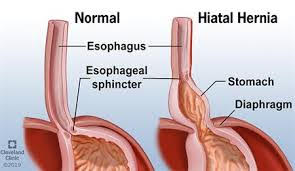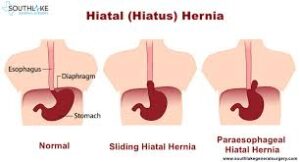A hernia is when an internal part of the body pushes into an area where it doesn’t belong. When eating, food will travel down the esophagus, which passes through a small opening (hiatus) in the diaphragm before entering the stomach. The lower esophageal sphincter (LES) is a valve that opens to let food in and closes to keep digestive acids and food in your stomach. The LES at the top of the stomach. When the diaphragm’s opening weakens, the stomach and LES valve protrude through the hiatus and diaphragm. When the top portion of the stomach either rolls or slides up into this opening and becomes stuck there, it becomes a hiatal hernia.

The LES valve cannot close correctly with a piece of the stomach wedged through the enlarged hiatal hole. Stomach acid will then reflux back up into the esophagus. This causes people to experience heartburn, inflammation, esophageal spasms, and sometimes ulcers. Unfortunately, hiatal hernia gets misdiagnosed because it mimics many disorders. A person with gastroesophageal reflux disease (GERD), may experience stomach aches that feel like an ulcer, chest pains, sometimes mimicking cardiac arrest. A common mistake we see often is treating the symptoms.
Many people believe their stomach is producing too much hydrochloric acid and run for the “Tums.” Antacids increase your chances of bone fractures, breaks, and developing osteoporosis. Poor posture can make a hiatal hernia worse by altering the stomach’s position, causing the hernia to squeeze the neighboring vagus nerve. The vagus nerve stimulates the release of hydrochloric acid (via proton pump). This causes over or under secretion of hydrochloric acid. It may also relax the pyloric sphincter at the bottom of the stomach, causing leakage of digestive juices that are needed to break food down properly.
Researchers found the University of Michigan Medical School cases where Hiatal hernias were responsible for heart palpitations due to stimulation of the vagus nerve. Suppose a person develops poor digestion due to decreased hydrochloric acid. In that case, they will have difficulty assimilating and digesting minerals and proteins, causing food putrefaction in the intestines and toxicity throughout the body. Lack of nutrition and toxicity may contribute to anemia, constipation, difficulty swallowing, food allergies, and immune system weakness. Gastric acid from decayed and fermented food can cause throat spasms that lead to thyroid gland irritation. Hiatal hernia sufferers frequently complain of not getting vitamins and large pills down, especially when they are capsules.
What causes a Hiatal hernia?
The causes of a hiatal hernia are not entirely known and can be unique to each individual. There could be a mechanical cause. Blows to the abdomen, hard coughing, obesity, a stressful event, and more frequently found; poor posture (hyperkyphosis) may contribute to the development of this problem. But, incorrect lifting may be the most damaging mechanical cause. If air is not exhaled from the lungs while lifting, the intra-abdominal pressure may force the stomach through the diaphragm. Most patients presenting with severe Hiatal hernias are under extreme stress and sympathetic nervous system overload. The best way to assess for a hiatal hernia is to have an endoscopy. The easiest method would be to place your fingers just below the sternum in the upper belly. Take a deep breath in and feel if your stomach expands. If you lack ab expansion and find yourself shrugging your shoulders during deep inhalation, a hiatal hernia may be restricting the movement of your diaphragm.
What are my Hiatal hernia treatment options?
Hiatal hernia is predominantly a mechanical problem. The easiest, safest, and best way to correct it is mechanically with a chiropractic hiatal hernia technique or maneuver along with cold laser therapy. Synergy wellness chiropractic & physical therapy in Manhattan, New York City treats and relieves stomach pain, acid reflux and GERD caused by hiatal hernia or a sliding hiatal hernia.

Another approach only treats the symptoms of acid reflux and does nothing to fix the hernia source. Medical doctors attempt surgery to correct a hiatal hernia in severe cases, but results tend to be poor. When Cutting into this area, it further weakens the diaphragm causing the hernia to return. A better method is to manipulate the stomach by hand and slide it down, as demonstrated in the video below.
References
- University of Michigan Medical School Clinical Cases: http://www.med.umich.edu/lrc/coursepages/m1/ anatomy2010/html/clinicalcases/hiatal_hernia/hiatal_hernia.html